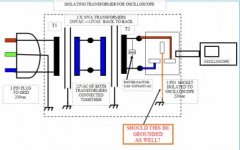Regarding isolation transformer use, it is ALWAYS recommended from a safety point of view to isolate the device under test and not the scope when isolation is necessary (which would be when probing the primary side of an isolated offline converter). This means you have to get a transformer that can handle the power of the SMPS so it will be bigger and more expensive than if you were isolating the scope.
Regarding only using 1 scope probe at once, SMPS design is considered to be one of few scenarios where the use of 4 channels simultaneously is frequently required. All channels must be referenced to the same ground otherwise the scope and the device could be damaged, but that's oscilloscopes 101 and is true for any circuit, not just SMPS. If you want to probe the primary and secondary sides of an isolated converter simultaneously, you'll be voiding the isolation, so you'd have to power the SMPS from an isolation transformer in this case.
Regarding only using 1 scope probe at once, SMPS design is considered to be one of few scenarios where the use of 4 channels simultaneously is frequently required. All channels must be referenced to the same ground otherwise the scope and the device could be damaged, but that's oscilloscopes 101 and is true for any circuit, not just SMPS. If you want to probe the primary and secondary sides of an isolated converter simultaneously, you'll be voiding the isolation, so you'd have to power the SMPS from an isolation transformer in this case.

